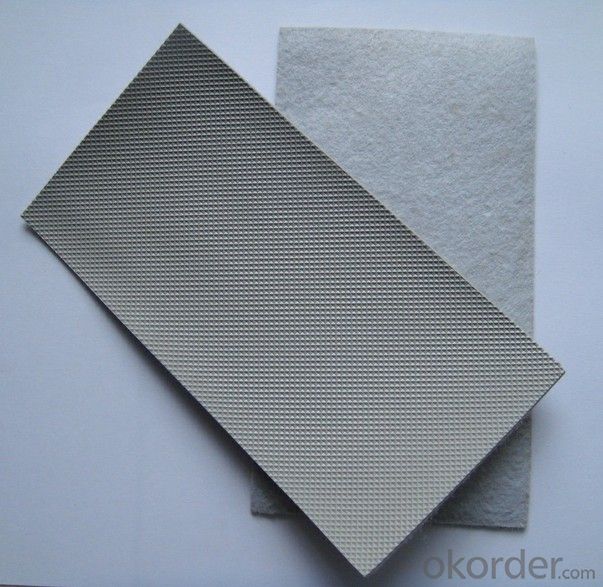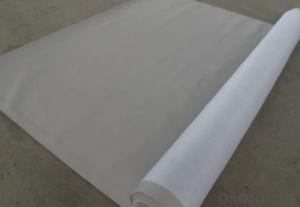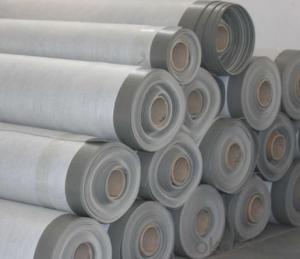PVC Waterproofing Membrane for Underground Leakage
- Loading Port:
- China main port
- Payment Terms:
- TT OR LC
- Min Order Qty:
- 5000 m²
- Supply Capability:
- 100000 m²/month
OKorder Service Pledge
OKorder Financial Service
You Might Also Like
Introduction of PVC Waterproofing Membrane:
PVC Self-adhesive Waterproof Membrane is a kind of synthetic polymer waterproof membrane which made from polymer self-adhesive polymer, uses Polymer sheet(PVC) as the original source. It has high tensile strength, perfect elongation, excellent resistance to punture and tear, the greatest feature the material is: Concrete can be pasted directly on the membrane surface, after the concrete has been setted, bond strength of membrane and concrete is greater than 2.0Mpa so as to solve the problem of membrane channeling water and leakage.
Features
1.High Tensile strength, excellent resistance to tear and puncture.
2.Strong adhesion with the concrete, effectively prevent the emergence of a single polymer sheet phenomenon of channeling water.
3.Lap with pre- self-adhesive side lap to ensure the seamless of waterproof system.
4.Perfect resistance to acid&alkali,weather and aging.
5.Simple operation, High work efficiency, Low cost.
6.Non toxic, tasteless and be environmentfriendly.
Scope of Application
Large-scale underground structures.
Surface of concrete slabs for planting.
For Roads, Rails, Subway tunnels projects.
For reservoirs, canals, dams and other water conservancy projects.
For air defense, military facilities waterproof projects.
Construction technology
Tunnels, bridges should use polmer sheet welding lap joints. Firstly, pre-paved polymer sheet side of polymer self-adhesive composite waterproof membrane toward the base, and fix it with dedicated pieces of machine, double lap weld seam welding machine should be used for lap joints. Tear off insulation paper, band reinforced concrete directly, self-adhesive waterproof membrane will adhere to the main body of concrete structure closely to achieve full adhesion.
General building underground projects should use self-adhesive overlap method. Basement bottom: pre-laying the membrane on cushion firstly(polymer sheet face down), tear off reserved isolation paper of lap joints self-adhesive side and can be sealed when paste directly; tear off isolation paper of self-adhesive waterproof layer, structural concrete, the membrane will anti-stick to the concrete structure to form dense waterproof system.
Basement side wall, Surface of concrete slabs for planting: attach the self-adhesive material side to the base surface directly, tear off reserved isolation paper of lap joints self-adhesive side. Side wall shall be fixed with dedicated pieces of machine.
Half header treatment:Wether horizontal half header or vertical half header, which should be sealed with sealant, membrane in the elevation without groove half header, it shall be fixed with metal straps firstly, then seal the top hole of metal straps and fixed screw with sealant.
Specification of PVC Waterproofing Membrane:
No. | Item | Model Ⅱ | |
1 | Tensile Strength Mpa ≥ | 12.0 | |
2 | Elongation at break% ≥ | 250 | |
3 | Shrinkage rate % ≤ | 2.0 | |
4 | Flexibility at low temperature | No crackle at -25oC | |
5 | Water tightness | Watertight | |
6 | Puncture resistance | Watertight | |
7 | Heat aging treatment | Appearance | Free from bubble, crack, cohesion and void |
Change rate of tensile strength % | +20oC | ||
Change rate of elongation at break | |||
Flexibility at low temperature | No crack at -20oC | ||
8 | Chemical corrosion resistance | Change rate of tensile strength % | +20 |
Change rate of elongation at break | |||
Flexibility at low temperature | No crack at -20oC | ||
9 | Artificial weathering | Change rate of tensile strength % | +20 |
Change rate of elongation at break | |||
Flexibility at low temperature | No crack at -20oC | ||
Remark: The property of artificial weathering might not be applicable to non-exposed product | |||
FAQ of PVC Waterproofing Membrane
a.Can we get some samples before place order?
Answer: We can send the free samples to you by freight collect.
b.How many years can your PVC membrane guarantee?
Answer: We will guarantee the quality for 5 years at least.
c.Which countries you ever export the product?
Answer: We export the PVC membrane to South Africa, Middle east and even European countries.

- Q:Can a waterproofing membrane be used on storage tanks?
- Yes, a waterproofing membrane can be used on storage tanks to prevent water leakage and protect the tank from corrosion.
- Q:Can a waterproofing membrane be used on roofs with rooftop gardens?
- Indeed, rooftops with gardens can benefit greatly from the utilization of a waterproofing membrane. Employing a waterproofing membrane is strongly advised as it shields the foundational framework from harm caused by water. Given that a rooftop garden contributes additional weight and moisture to the roof, it is imperative to have a reliable waterproofing system in place to avert leaks and guarantee the roof's durability. The waterproofing membrane serves as a safeguard against water infiltration, effectively maintaining dry conditions for both the rooftop garden and the underlying structure.
- Q:Are there any specific considerations for installing a waterproofing membrane on wood surfaces?
- Yes, there are several specific considerations when installing a waterproofing membrane on wood surfaces. First and foremost, it is important to ensure that the wood surface is clean, dry, and free from any dirt, dust, or debris. This will help to create a proper bond between the wood and the waterproofing membrane. Additionally, it is crucial to choose a waterproofing membrane that is specifically designed for wood surfaces. There are different types of membranes available, such as liquid-applied membranes or sheet membranes, so selecting the right one is essential. Before applying the membrane, it is advisable to prime the wood surface with a suitable primer. This will help to enhance the adhesion of the membrane and provide a more durable and long-lasting waterproofing solution. It is also important to consider the climate and weather conditions in the area where the wood surface is located. If the area is prone to extreme temperatures or heavy rainfall, it is recommended to choose a waterproofing membrane that can withstand these conditions and provide adequate protection. Furthermore, proper installation techniques should be followed to ensure the membrane is applied correctly. This may involve rolling or brushing the membrane onto the wood surface, as per the manufacturer's instructions. It is crucial to pay attention to details such as seams, corners, and edges to ensure a watertight seal. Regular maintenance and inspection are essential for the longevity of the waterproofing membrane on wood surfaces. It is important to check for any signs of damage, such as cracks or peeling, and address them promptly to prevent water infiltration and potential damage to the wood. In summary, when installing a waterproofing membrane on wood surfaces, it is crucial to prepare the surface properly, choose the right type of membrane, consider the climate and weather conditions, follow proper installation techniques, and perform regular maintenance and inspection. By doing so, you can effectively protect the wood surface from water damage and ensure its longevity.
- Q:Can a waterproofing membrane be used in historical or heritage buildings?
- Indeed, historical or heritage buildings can utilize a waterproofing membrane. Nevertheless, prior to implementing any waterproofing solution, it is imperative to take into account the specific requirements and sensitivities associated with these types of structures. Historical or heritage buildings often possess distinctive architectural characteristics, materials, and construction methods that necessitate preservation and safeguarding. When employing a waterproofing membrane in historical or heritage buildings, it is of utmost importance to choose a product that is compatible with the existing materials and will not cause any harm or modification to the structure. It is advisable to seek guidance from a professional architect or preservation specialist with expertise in working with historical buildings. This will ensure that the chosen waterproofing membrane is appropriate for the specific needs of the building. Furthermore, it is vital to consider the visual impact of the waterproofing membrane on the building's appearance. Historical or heritage buildings frequently showcase unique architectural details and façades that contribute to their character and value. Hence, the selection of the waterproofing membrane should be done with great care to ensure that it does not detract from the building's historical significance or visual allure. In conclusion, while it is possible to employ a waterproofing membrane in historical or heritage buildings, it should be done with caution. The utmost consideration should be given to the building's materials, construction techniques, and aesthetic worth to guarantee that the waterproofing solution does not compromise the structure's integrity or historical importance.
- Q:Can a waterproofing membrane be used in conjunction with landscaping or hardscaping projects?
- Yes, a waterproofing membrane can be used in conjunction with landscaping or hardscaping projects. It can provide an additional layer of protection and help prevent water damage to structures or areas where landscaping or hardscaping is being done.
- Q:Can a waterproofing membrane be used for a stadium?
- Indeed, a stadium can benefit from the utilization of a waterproofing membrane. Specifically engineered to serve as a barrier against water infiltration, this membrane proves to be an optimal solution for safeguarding the structure of a stadium against any water-related damage. Its application can encompass various areas of the stadium, including the roof, walls, and foundation, effectively preventing leaks and the seepage of moisture. In addition, the implementation of a waterproofing membrane can play a crucial role in prolonging the lifespan of the stadium, shielding it from the detrimental consequences of water, such as corrosion and the growth of mold. In summary, the usage of a waterproofing membrane for a stadium represents a pragmatic and efficient approach to ensuring its durability and longevity.
- Q:Can a waterproofing membrane be applied to wood surfaces?
- Wood surfaces can indeed be protected with a waterproofing membrane. There are various options available in the market, including liquid or sheet membranes that are specially designed for wood. These membranes are typically made from materials like rubber, asphalt, or polyurethane, which form a barrier against water and prevent moisture from seeping into the wood. The application of the waterproofing membrane varies depending on the product, and can involve brushing, rolling, or spraying. By applying a waterproofing membrane to wood surfaces, the wood's lifespan can be extended, rotting and warping can be prevented, and water damage can be avoided. However, it is crucial to properly prepare the surface and follow the manufacturer's instructions for application in order to achieve optimal results.
- Q:Can a waterproofing membrane be used for underground stormwater detention systems?
- Yes, a waterproofing membrane can be used for underground stormwater detention systems. Waterproofing membranes are commonly used to prevent water penetration and can be effective in containing stormwater within the underground detention system.
- Q:Can waterproofing membranes be used on mechanical rooms?
- Yes, waterproofing membranes can be used on mechanical rooms. Mechanical rooms often house equipment such as boilers, pumps, and ventilation systems, which can be sensitive to water damage. Waterproofing membranes provide a protective barrier against water infiltration and can help prevent leaks, moisture buildup, and potential damage to the equipment. Additionally, these membranes can also provide thermal insulation, noise reduction, and fire resistance properties. It is important to choose the appropriate type of waterproofing membrane based on the specific needs and requirements of the mechanical room.
- Q:What type of maintenance is required for a waterproofing membrane?
- To properly maintain a waterproofing membrane, regular inspections and routine maintenance are necessary. Firstly, it is important to keep the surface clean and free from debris that could potentially damage the membrane. Regularly remove any dirt, leaves, or other foreign materials that may accumulate on the surface. Inspect the membrane for any signs of wear, tear, or damage, such as cracks, blisters, or punctures. If any issues are found, they should be repaired promptly to prevent water leakage and potential further damage. Additionally, it is recommended to inspect and maintain the surrounding areas of the membrane, including gutters, downspouts, and drainage systems. Ensure that these components are functioning properly and free from any blockages that could compromise the effectiveness of the waterproofing system. Depending on the type of waterproofing membrane used, it may require periodic reapplication of a protective coating or sealant. This will help to extend the lifespan of the membrane and ensure its continued effectiveness. It is also essential to monitor the membrane's performance during heavy rain or snow events. Check for any signs of water pooling or leakage, and address any problems promptly. Overall, regular inspections, routine cleaning, prompt repairs, and necessary reapplication of protective coatings are key maintenance tasks to ensure the longevity and effectiveness of a waterproofing membrane.
1. Manufacturer Overview |
|
|---|---|
| Location | |
| Year Established | |
| Annual Output Value | |
| Main Markets | |
| Company Certifications | |
2. Manufacturer Certificates |
|
|---|---|
| a) Certification Name | |
| Range | |
| Reference | |
| Validity Period | |
3. Manufacturer Capability |
|
|---|---|
| a)Trade Capacity | |
| Nearest Port | |
| Export Percentage | |
| No.of Employees in Trade Department | |
| Language Spoken: | |
| b)Factory Information | |
| Factory Size: | |
| No. of Production Lines | |
| Contract Manufacturing | |
| Product Price Range | |
Send your message to us
PVC Waterproofing Membrane for Underground Leakage
- Loading Port:
- China main port
- Payment Terms:
- TT OR LC
- Min Order Qty:
- 5000 m²
- Supply Capability:
- 100000 m²/month
OKorder Service Pledge
OKorder Financial Service
Similar products
New products
Hot products
Related keywords



























